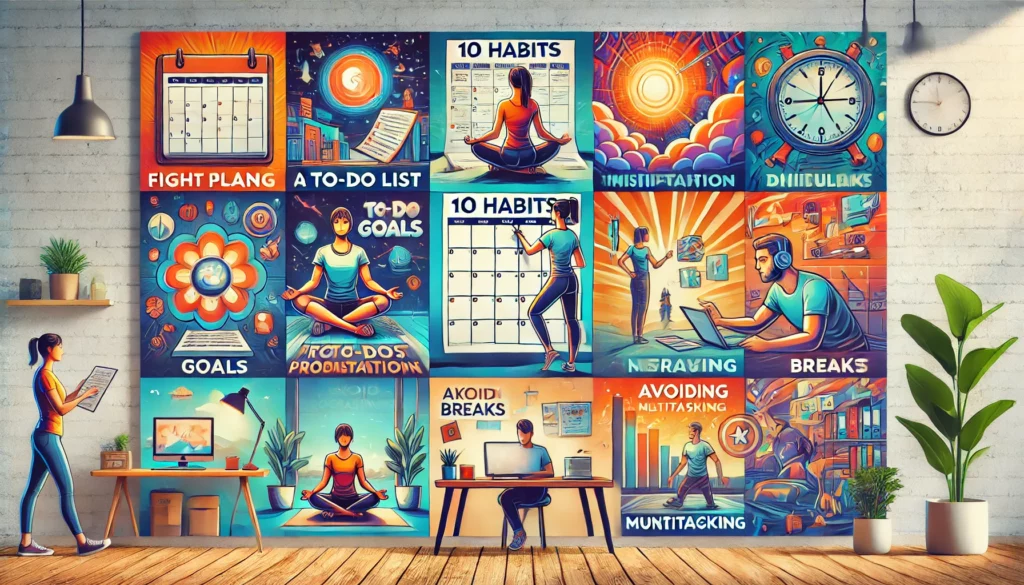Procrastination is a common obstacle to productivity. Despite knowing what needs to be done, distractions and a lack of motivation often hinder progress. Overcoming procrastination isn’t solely about working harder; it’s about cultivating habits that facilitate focus and prompt action.
In this article, you’ll discover ten effective habits to help you stop procrastinating, enhance concentration, and maintain productivity without feeling overwhelmed.
1. Start with a Small, Easy Task (The 2-Minute Rule)
Initiating a task can often be the most challenging part. The 2-Minute Rule suggests starting with an action that takes two minutes or less, making it easier to begin.
How to Apply It:
- If you need to write an essay, start by writing just one sentence.
- If you plan to exercise, begin by putting on your workout clothes.
- If you need to clean, pick up and put away one item.
Why It Works: Starting with a small task reduces the psychological barrier to beginning, often leading to continued effort beyond the initial action.
2. Use the Pomodoro Technique to Stay Focused
The Pomodoro Technique involves working in focused intervals followed by short breaks, enhancing concentration and preventing burnout.
How to Apply It:
- Work for 25 minutes, then take a 5-minute break.
- After four cycles, take a longer break of 15–30 minutes.
- Use timers or apps to track your intervals.
Why It Works: This method leverages the brain’s ability to focus intensely for short periods, improving productivity and reducing fatigue.
3. Plan Your Day the Night Before
Decision fatigue can lead to procrastination. Planning your tasks in advance eliminates uncertainty and provides a clear roadmap for the day.
How to Apply It:
- Before bed, list your top three tasks for the next day.
- Prioritize tasks based on importance and deadlines.
- Prepare your workspace to facilitate immediate action.
Why It Works: Having a predetermined plan reduces the time spent deciding what to do, allowing for a more focused and productive day.
4. Remove Distractions Before You Start
An environment filled with distractions can significantly hinder focus. Proactively minimizing these interruptions can enhance concentration.
How to Apply It:
- Turn off non-essential notifications on your devices.
- Use website blockers to prevent access to distracting sites.
- Keep your workspace tidy and free from clutter.
Why It Works: A distraction-free environment allows for sustained attention on tasks, reducing the likelihood of procrastination.
5. Set Clear Deadlines for Every Task
Tasks without specific deadlines can be perpetually postponed. Establishing clear timeframes creates a sense of urgency and accountability.
How to Apply It:
- Assign a specific deadline to each task, even if one isn’t externally imposed.
- Break larger projects into smaller tasks with individual deadlines.
- Use calendars or task management tools to track these deadlines.
Why It Works: Deadlines provide structure and motivate timely completion of tasks.Verywell Mind
6. Reward Yourself for Taking Action
Immediate rewards can reinforce positive behaviors and make task completion more satisfying.
How to Apply It:
- After completing a task, take a short break to enjoy a favorite activity.
- Treat yourself to something enjoyable after reaching a milestone.
- Use a reward system to motivate progress on challenging tasks.
Why It Works: Rewards provide positive reinforcement, making it more likely that productive behaviors will be repeated.
7. Focus on One Task at a Time
Multitasking can reduce efficiency and increase errors. Concentrating on a single task ensures higher quality and faster completion.
How to Apply It:
- Prioritize tasks and tackle them sequentially.
- Avoid switching between tasks frequently.
- Allocate specific time blocks for individual tasks.
Why It Works: Focusing on one task minimizes cognitive load and enhances performance.
8. Use the “5-Second Rule” to Take Immediate Action
Hesitation can lead to procrastination. The 5-Second Rule encourages immediate action to prevent overthinking.
How to Apply It:
- When you feel the urge to procrastinate, count down from five and then start the task.
- Use this countdown to interrupt negative thought patterns and initiate movement.
Why It Works: This technique leverages quick decision-making to overcome inertia and begin tasks promptly.
9. Break Big Tasks into Smaller Steps
Large projects can feel overwhelming, leading to avoidance. Dividing them into manageable parts makes them more approachable.
How to Apply It:
- Identify the components of a larger task and list them as individual steps.
- Focus on completing one step at a time.
- Celebrate progress as each step is completed.
Why It Works: Smaller tasks are less intimidating and provide a clear path toward completing the larger project.
10. Build a Daily Habit of Taking Action
Consistency in taking action reduces the tendency to procrastinate and builds momentum toward productivity.
How to Apply It:
- Set aside dedicated time each day for focused work.
- Establish routines that signal the start of productive periods.
- Track your progress to maintain motivation.
Why It Works: Regular practice of taking action reinforces productive habits and diminishes procrastination tendencies.
Embrace Small Changes for Lasting Productivity
Overcoming procrastination involves developing habits that promote focus and action. By implementing these strategies, you can enhance productivity and reduce the stress associated with delayed tasks.
Start Today: Choose one habit from this list and integrate it into your routine. Small, consistent changes can lead to significant improvements in managing procrastination and boosting focus.
Gabriel Silva is the founder of Cursos e Soluções, a blog dedicated to personal growth, habit change, and self-discipline. Passionate about self-development and productivity, he shares practical, research-backed strategies to help people achieve their goals. He believes that small, consistent changes can lead to significant transformations over time and is committed to providing content that empowers both personal and professional success.







